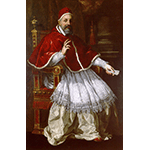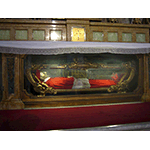Hopes (1624-1631)
Those who imagined that prohibitions, insults, provocations, or even threats would persuade Galileo to abandon his world system were greatly in error. The conviction of 'having in his mind things of importance for the learned world' was equal to his innate stubbornness. The expression of thought can be inhibited, but the act of thought, apart from drastic solutions, fortunately cannot. And Galileo had never lost hope of the rehabilitation of Copernican thought; unless its truth could be recognised, his world would remain forever warped. The election of Pope Urban VIII seemed an occasion to be grasped immediately. A few years before, in the grip of poetic inspiration, the pope-to-be had composed verses full of wondering admiration, significantly entitled Adu latio perniciosa [Pernicious adulation], in praise of the 'lens' of the 'learned Galileo' and the 'skill' that had allowed him to use it so profitably. Galileo's Roman friends too were enthusiastic, especially those associated with the Academy of the Lincei, some of whom had been called upon to form part of the papal entourage and had told Galileo how much the Pope had appreciated the dedication of The Assayer, so much so that he even had it 'read to him at table.' Further encouragement may have came from meetings Galileo probably had in 1616 with the future Pope in person. A dove among the hawks of the Inquisition, the then Cardinal Barberini must have worked to keep the theory of the Earth's mobility from being branded as heresy, and Galileo must have appreciated his more flexible approach.
The years from 1624 to 1631 were dense with activity. Galileo was absorbed in a new work, the most important of his life, which he succeeded in completing in spite of the time taken up by his frenetic diplomatic activity and his widespread network of contacts. Two journeys to Rome became necessary, in 1624 and again in 1630, as well as continuous correspondence, especially with Academicians of the Lincei who took on direction of the enterprise in Rome, having assumed responsibility for printing this work. All this represented a considerable burden for Galileo, now, at sixty, entering what was seen then as old age and constitutionally of fragile health. 'Courting is an activity for young men,' he wrote from Rome in 1624, 'who, with the robustness of their bodies and the enticement of hopes, are strong enough to tolerate such effort.' To think that his daughter Virginia had worried even about the walks Galileo took in the hills around Florence! Visiting her was no easy matter: from the villa at Bellosguardo to the convent at Arcetri the road was long, even on mule-back. His son, who in the meantime had married Sestilia Bocchineri, of a well-to-do family, had acquired, thanks to the generous dowry, a comfortable house on the Costa S. Giorgio 'with a vegetable garden, water cistern and courtyard', which was closer to his sisters' residence. But Galileo did not live with him, continuing to prefer the isolation of his own hillside. Virginia, unresigned to this situation, busied herself to find an alternative and within a few years persuaded her father to move nearer: 'Now I have just heard of Signor Esał Martellini's villa at Pian dei Giullari, very close to us.' Galileo was to rent this in 1631 and the villa, Il Gioiello, near the convent of Arcetri, was to become the scene of the disappointment and unhappiness that poisoned the last years of his life.
In Rome, in 1624 Galileo had met a number of influential people, had received encouragement and assurances and had been given many gifts by the Pope, including a painting, a gold and a silver medal, a pension for his son, a laudatory brief to be handed to the Grand Duke, and 'a good number of Agnus Dei prayers.' In 1630 he brought home also the imprimatur for his new work, now finished, which was to have been printed in Rome. But he never obtained what he most wanted: public recognition of Copernicanism.
Were the views of Urban VIII really so different from those held officially by the Church up to then? The answer, it must be said, is an emphatic no. According to his personal theologian, Barberini, in line with the late Cardinal Bellarmine, gave further force to the subordination of science to Scripture by bringing divine omnipotence into the question. To human reason, essentially weak, the concept of a moving Earth explained the appearances of the phenomena. But God, being omnipotent, would have had infinite other ways, incomprehensible to limited human reason", of producing the same phenomena. Could weak human reason demonstrate the incongruence of any other structure in the universe, established by omnipotent God, that might give rise to exactly the same phenomena? Obviously, it could not. Consequently, regarding as true only one of these possible structures of the universe, the one that seemed the more plausible to weak human reason was purely illusory knowledge and should be abandoned in favour of the holy texts, which may be less convincing to a mathematical mind (also weak), but are always the word of omnipotent God and thus unquestionable. On these premises, the whole of scientific progress became pure illusion and nothing could be regarded as acquired knowledge. As it was impossible to refute each individual scientific achievement, no course was open but to negate the very possibility of science, acknowledging revelation as the only human path to knowledge. It seemed as if Barberini had never really wanted to have the hypothesis that the Earth moved condemned as heresy, content to call it 'daring', as was reported to Galileo, being basically convinced that there was no need 'to fear that anyone would ever be able to demonstrate that it was necessarily true.'
Needless to say, Galileo's attitude was completely different. For him science had its own field of action, particular to it and autonomous. It was concerned, not with understanding 'what God could do', but rather with 'what He had done', as he commented regarding a French mathematician who held similar opinions to those of Barberini. Certainly, to show his omnipotence, God could have caused birds to fly 'with their bones made of solid gold, their veins full of quicksilver, their flesh heavier than lead, and with their wings exceedingly small and heavy'; and he could have made fish heavy too. But he did not do so. Instead he 'preferred to make the former with bones, flesh and feathers very light in weight', so that they could fly, and the latter the 'same weight as water' so that they could swim. God, in fact, 'delights in simplicity and facility', that is, he takes pleasure in the clear, precise laws that govern nature. And moreover, was not nature itself divine language, a mathematical language at that?
Theology and science were now travelling on two parallel tracks, never again to meet, and this palpable contrast boded ill for the future. Fate also contributed to the gathering of other clouds on the horizon. In August 1630 Federico Cesi died. Galileo thus lost a strong supporter on the practical side of his work but, above all, his chief advocate in Roman circles, where Cesi had acted as a cushion through his network of mediation, thus considerably lessening the risks inherent in Galileo's difficult temperament. Then came the plague. With epidemic sweeping through Italy, objects could not be transported unless subjected to dangerous disinfection procedures. It was not safe to circulate Galileo's manuscript, just completed, in these precarious conditions. And what could Rome now offer him more than Florence? On the advice of all, Galileo decided to print his book at home. In his eagerness to publish it and in the precipitous course of events that followed, he failed to recognise the signs of a contrary wind.
****************************
Texts by Sara Bonechi
English translation by Anna Teicher
Last update 16/gen/2008







